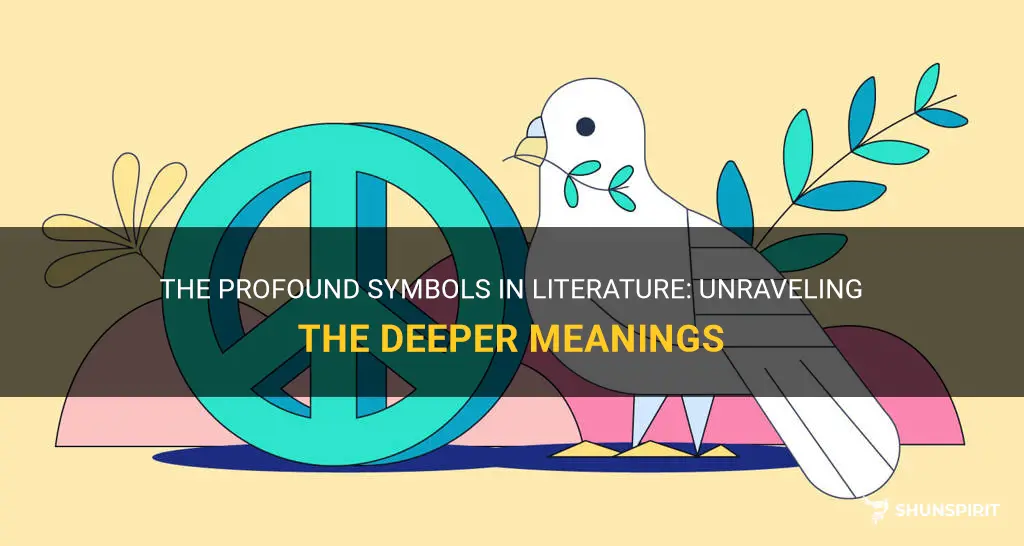
Symbolism is a powerful literary device that allows authors to convey deep meanings and messages through the use of symbols. These symbols can be objects, actions, or even characters that represent abstract ideas or concepts. By incorporating symbolism into their writing, authors are able to add layers of complexity and depth to their work, encouraging readers to look beyond the surface level and engage in thought-provoking analysis. Whether it's the green light in The Great Gatsby or the mockingbird in To Kill a Mockingbird, symbolism has the ability to transform a story into a rich and meaningful experience for readers.
What You'll Learn
- What is the role of symbolism in literature?
- How does symbolism enhance the meaning of a literary work?
- Are there common symbols used in literature, and what do they typically represent?
- Can symbolism have different interpretations for different readers?
- How does an author decide which symbols to include in their work?

What is the role of symbolism in literature?
Symbolism plays a crucial role in literature, as it allows authors to convey deeper meanings and emotions beyond what is explicitly stated in the text. Through the use of symbols, authors create a connection between the tangible and intangible, enabling readers to explore complex themes, ideas, and emotions.
One of the primary functions of symbolism is to enhance storytelling and evoke emotional responses from readers. By using symbols, authors can tap into universal human experiences and communicate ideas that may be difficult to express directly. For example, a red rose often symbolizes love and passion, bringing to mind notions of desire and romance. Through this symbol, an author can convey the intensity of a character's emotions and create a deeper emotional impact on the reader.
Symbols can also be used to represent broader concepts or abstract ideas. For instance, a dove is often used to symbolize peace and freedom. By incorporating this symbol into a narrative, an author can comment on societal issues or explore themes of peace and war. In this way, symbolism can add depth and nuance to a story, allowing readers to engage with complex ideas and contemplate their significance.
Furthermore, symbolism can also be used to foreshadow or convey hidden messages within a literary work. Authors often employ recurring symbols throughout a narrative to establish patterns and hint at future events. This creates a sense of anticipation and adds layers of interpretation for readers. An example of this can be seen in the use of the color red in Nathaniel Hawthorne's "The Scarlet Letter." The color red is used to symbolize sin and passion, allowing readers to anticipate the moral consequences that the characters will face.
In addition to enriching the storytelling experience, symbolism in literature also allows authors to explore cultural and historical contexts. Symbols can carry cultural significance, reflecting the values, beliefs, and traditions of a particular society or time period. By utilizing these symbols, authors can provide a deeper understanding of the social, political, or religious climate in which the story is set. This not only adds authenticity to the narrative but also invites readers to engage with different perspectives and broaden their own understanding of the world.
In conclusion, symbolism plays a vital role in literature by providing a means for authors to convey deeper meanings and emotions. Through the use of symbols, authors can enhance storytelling, explore abstract ideas, foreshadow events, and reflect cultural and historical contexts. Symbolism allows readers to engage with complex themes and emotions, making the reading experience more profound and thought-provoking. By incorporating symbolism into their works, authors can create richer narrative experiences that resonate with readers long after they have finished the story.
The Mythical Power and Symbolism Behind the Mjolnir: Exploring the Deeper Meaning of Thor's Hammer
You may want to see also

How does symbolism enhance the meaning of a literary work?
Symbolism is a powerful literary tool that authors use to enhance the meaning of their works. It adds depth and complexity to the story by using objects, actions, and characters to represent abstract ideas and concepts. By utilizing symbolism, authors are able to convey deeper messages and evoke emotional responses from readers.
One of the main ways symbolism enhances the meaning of a literary work is by adding layers of interpretation. Symbols often have multiple meanings, allowing readers to analyze and interpret the text on various levels. They can represent universal ideas or personal experiences, giving readers the opportunity to connect with the story on a deeper level. For example, in F. Scott Fitzgerald's novel "The Great Gatsby," the green light at the end of Daisy's dock represents Gatsby's unattainable dream of a life with Daisy, as well as the elusive nature of the American Dream itself. This symbol carries multiple layers of meaning, allowing readers to analyze the characters and themes in a more profound way.
Furthermore, symbolism can amplify the emotional impact of a story. By using objects or actions to represent abstract concepts, authors create powerful images that evoke strong emotions in readers. For instance, in Harper Lee's "To Kill a Mockingbird," the mockingbird represents innocence and goodness. When Boo Radley saves Scout and Jem from Bob Ewell, the act of killing a mockingbird, a symbol of innocence, is avoided, intensifying the emotional impact of the scene. Through the use of symbolism, readers are able to empathize with the characters and become emotionally invested in the story.
Symbolism also allows authors to comment on societal issues and critique the world around them. By using symbols to represent larger concepts, authors can explore themes of power, corruption, and inequality. In George Orwell's novel "Animal Farm," the pigs represent the corrupt leaders who misuse their power, while the other animals symbolize the oppressed working class. Through this allegorical representation, Orwell criticizes the abuse of power and the dangers of totalitarianism. The use of symbols enables authors to present social and political commentary in a way that is relatable and impactful.
In conclusion, symbolism is a crucial element in literature that enhances the meaning of a literary work in various ways. It adds depth and complexity to the story, allows for multiple interpretations, intensifies emotional impact, and enables authors to comment on societal issues. Through the use of symbols, authors create a rich and nuanced reading experience, engaging readers on both an intellectual and emotional level. The power of symbolism lies in its ability to transcend language and cultural barriers, making it a universal tool that enriches the meaning of literary works.
Exploring the Rich Symbolism and Meanings of Haitian Culture
You may want to see also

Are there common symbols used in literature, and what do they typically represent?
Symbolism is a literary tool that writers often employ to enhance the meaning and depth of their works. Symbols are objects, characters, or events that represent abstract ideas or concepts. They can be found in a variety of literary genres, including novels, plays, and poems. While there are countless symbols used in literature, a few common ones and their typical representations can be identified.
One of the most well-known symbols is the dove, often used to symbolize peace and tranquility. This association stems from the biblical story of Noah and the Ark, where a dove returns to the Ark with an olive branch, signifying the end of the flood and the restoration of peace. In literature, the dove is often employed to represent a desire for peace or the presence of hope amidst chaos.
Another common symbol is the rose, which typically symbolizes love and beauty. The rose has been used as a symbol of romantic love for centuries, often representing the beauty and passion that can be found in relationships. However, roses can also symbolize other concepts, such as purity, fragility, or even danger depending on how they are portrayed in a specific work of literature.
The use of the color white is another prevalent symbol in literature. White is often associated with notions of purity, innocence, and goodness. This symbolism can be seen in works such as Nathaniel Hawthorne's "The Scarlet Letter," where the color white is used to represent the purity and innocence of Pearl. Conversely, white can also represent emptiness or sterility, as seen in Ernest Hemingway's "Hills Like White Elephants," where the barren landscape is described as white and devoid of life, mirroring the characters' struggle with fertility and the potential loss of innocence.
The symbol of the serpent is also commonly found in literature, representing different ideas depending on the context. In religious texts, the serpent is often associated with evil or temptation, as seen in the story of Adam and Eve in the Garden of Eden. In literature, the serpent can symbolize deceit, manipulation, or even wisdom, as demonstrated in William Shakespeare's "Macbeth," where the serpent is used to represent the treacherous nature of Macbeth's character.
Additionally, the symbol of the cross is widely recognized as a representation of Christianity and sacrifice. In literature, the cross can be used to symbolize selflessness, martyrdom, or the acceptance of suffering for a greater purpose. For example, in Fyodor Dostoevsky's "Crime and Punishment," the main character Raskolnikov struggles with the guilt of his actions and ultimately finds redemption through his self-sacrifice, paralleling the Christian symbolism of the cross.
These are just a few examples of the many symbols used in literature and the meanings they typically convey. However, it is important to note that symbols can be subjective and may carry different interpretations depending on the reader's background and personal experiences. The power of symbolism lies in its ability to evoke emotions, provoke thought, and add depth to the overall themes and messages of a literary work.
Exploring the Different Meanings Behind Star Symbols
You may want to see also

Can symbolism have different interpretations for different readers?
Symbolism is a literary technique that uses objects, actions, or ideas to represent abstract concepts. It is a powerful tool that adds depth and complexity to a piece of writing, allowing readers to engage with the text on a deeper level. However, the interpretation of symbolism can vary from reader to reader, leading to different understandings and perspectives. This flexibility is one of the fascinating aspects of symbolism in literature.
One of the reasons why symbolism can have different interpretations for different readers is the subjective nature of perception. Each person brings their unique experiences, beliefs, and emotions to the reading process. These individual differences influence how readers interpret the symbols within a text. For example, a red rose may symbolize love and passion for one reader, while for another reader, it may represent beauty and romance. This divergence in interpretation enriches the reading experience and allows readers to connect with the text in their own personal way.
Another factor that contributes to the diverse interpretations of symbolism is the cultural context in which the reader is situated. Symbols often draw on cultural references and collective knowledge. For instance, a white dove is commonly associated with peace in Western culture, while in some eastern cultures, it may symbolize love and fidelity. Therefore, readers from different cultural backgrounds may assign different meanings to the same symbol based on their cultural context. This cultural diversity fosters a deeper understanding and appreciation of different interpretations.
Additionally, the author's intention or purpose for using symbolism may not always be clear or explicit. Authors often leave symbols open-ended, allowing readers to decipher their meanings independently. This intentional ambiguity enables readers to engage with the text actively, as they try to unravel the layers of symbolism and search for deeper meanings. In this way, each reader becomes an active participant in interpreting the symbols according to their own understanding and imagination.
Furthermore, readers' interpretations of symbolism can be influenced by their emotional state and personal experiences at the time of reading. Emotions and experiences shape our perspectives and influence how we connect with the symbols in a text. For example, a reader who has recently gone through a heartbreak may interpret the symbol of a broken mirror as representing shattered dreams and a loss of self-identity. On the other hand, a reader experiencing a period of self-reflection may interpret the same symbol as a sign of personal growth and transformation. These emotional and experiential lenses add richness and nuance to the interpretation of symbolism.
In conclusion, symbolism in literature is open to diverse interpretations for different readers. The subjective nature of perception, cultural context, ambiguity in the author's intention, and readers' emotional states and personal experiences all contribute to the variability in understanding symbolism. This multiplicity of interpretations enhances the richness and depth of the reading experience, allowing readers to engage with the text in a more personal and meaningful way. Symbolism, therefore, holds the power to evoke different emotions and stimulate various thoughts and connections, making it a fundamental aspect of literature that transcends boundaries and resonates with readers across cultures and time.

How does an author decide which symbols to include in their work?
Symbolism is a powerful literary device that authors use to add depth and meaning to their works. Symbols can enhance the overall message of a story, create a deeper connection between the reader and the text, and add layers of interpretation to the narrative. But how do authors decide which symbols to include in their work? What factors influence their choices? This article will explore the process behind an author's selection of symbols and shed light on the thought and reasoning that goes into this decision.
One crucial factor that influences an author's decision to include symbols in their work is the overall theme or message they want to convey. Symbols are often used to represent abstract ideas or concepts. For example, a dove could represent peace, while a snake might symbolize deceit or evil. By carefully selecting symbols that align with the central theme, authors can reinforce their message and make it more impactful. This selection process is often guided by the author's personal beliefs, values, and intentions, as they choose symbols that resonate with their own understanding of the world.
Another factor that plays a role in an author's decision-making process is the intended audience of their work. Different symbols can have varying cultural or historical connotations, and authors must consider how their intended readers will interpret these symbols. For instance, certain symbols may hold religious significance or cultural associations that could influence the reader's understanding of the narrative. Authors may choose symbols that are universally recognized or ones that cater specifically to their target audience, depending on the effect they wish to achieve.
Additionally, an author may draw inspiration from external sources such as mythology, folklore, or literary traditions. These sources often provide a wealth of pre-established symbols that have been ingrained in the collective consciousness of readers. By utilizing familiar symbols, authors can tap into the collective knowledge and understanding of their audience, making it easier for readers to connect with the text.
The context in which the symbols are used also influences an author's decision. Symbols can be woven into the narrative through various literary devices such as foreshadowing, allegory, or imagery. Authors may strategically place symbols at key moments in the story to create a specific effect or to enhance the reader's emotional response. The symbols can serve as a thread that connects different elements of the plot, tying the narrative together and adding a layer of depth to the story.
Finally, an author's own creativity and imagination play a significant role in the selection of symbols. Each author has a unique perspective and artistic vision, and the symbols they choose are a reflection of their creative process. Authors may draw inspiration from their own experiences, dreams, or personal symbolism to create a rich tapestry of symbols that resonate with both the narrative and the reader.
In conclusion, the selection of symbols in a literary work is a thoughtful and intentional process. Authors consider various factors such as the central theme, the intended audience, external sources, the narrative context, and their own creativity when deciding which symbols to include. The chosen symbols serve to enhance the overall message of the story, create a deeper connection with the reader, and add layers of interpretation. As readers, it is our task to unravel the symbolism embedded in the text and appreciate the intricate choices made by the author.
Understanding Traffic Signs and Symbols: Decoding their Meanings
You may want to see also
Frequently asked questions
Symbolism in literature is the use of symbols, objects, or actions to represent abstract ideas or qualities. These symbols can add depth and meaning to a story and allow readers to interpret the text on multiple levels.
What is the purpose of symbolism in literature?
The purpose of symbolism in literature is to communicate deeper meanings and themes. It allows authors to explore complex ideas and emotions that may be difficult to convey directly through words. Symbolism can create a richer reading experience and encourage readers to think critically about the text.
How do authors use symbolism in literature?
Authors use symbolism in literature by carefully selecting and incorporating symbols into their writing. These symbols may be recurring motifs, objects, or actions that have a deeper meaning beyond their literal function in the story. Through the use of symbolism, authors can create layers of meaning and invite readers to engage with the text in a more profound way.







